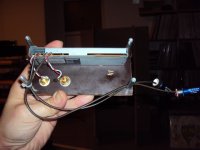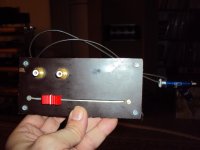is the purest approach to a preamp a passive preamp if you have a high input impedance power amplifier? Then why are there so many expensive preamps on the market? Do they add some sort of sonic signature which isn't on the recording?
A power amplifier wouldn't usually have enough gain for a passive preamplifier.
Sonic signature? That is snake oil. If the output isn't a faithful reproduction of the input, it's not hi fi. Any distortion added may be pleasing to some but, since it's uncontrolled, is not for anyone who cares about the program material.
Sonic signature? That is snake oil. If the output isn't a faithful reproduction of the input, it's not hi fi. Any distortion added may be pleasing to some but, since it's uncontrolled, is not for anyone who cares about the program material.
Actually, these days, passive is more reasonable than in the past. This is because we have standardized many power amps with the Holman THX level of gain, in order to standardize for working with other amps. This new level is about 28, or 0.1V input gives you 1W output, and 1V input gives you 100W output, and so on. IF your loudspeaker is reasonably efficient, and your listening levels normal, passive might be a great way to go.
Then why are there so many expensive preamps on the market?
Call me cynical if you will, but I've got the feeling that much of it is about selling into a self-deluding niche! In other words making money from people who simply believe that they *need* the product.
I was just reading about a Vitus Audio preamplifier which was $30,000 and I am sure that if your source has a normal output and your power amps have normal sensitivity then a DACT stepped attenuator with a Pass B1 and decent power supply would be just as good. That’s a $28,000 saving, but those considering the Vitus would never consider it. It’s all psychological!!!
Call me cynical if you will, but I've got the feeling that much of it is about selling into a self-deluding niche! In other words making money from people who simply believe that they *need* the product.
I was just reading about a Vitus Audio preamplifier which was $30,000 and I am sure that if your source has a normal output and your power amps have normal sensitivity then a DACT stepped attenuator with a Pass B1 and decent power supply would be just as good. That’s a $28,000 saving, but those considering the Vitus would never consider it. It’s all psychological!!!
well this is what I'm trying to find out. It could be psychological or it could be that it adds a subtle sonic signature whether it be intended or not.
I dont even understand why you'd need a buffer like the B1. How common is impedance mismatch?
A 10kOhm passive preamp works if you keep the cable short and use a cable with low capacitance. Other wise you loose treble. I use Alps studio faders as a bechmark for my active designs. Good active designs can have higher subjective dynamics though.
Saving $28k by not buying a $30k preamp? I can save the whole $30k and it will sound just as good. There is no magic except, as is said, in the mind. Perceived value is what it's all about. Why buy a Ferrari when you can't even get it out of third gear on today's roads? And Ferraris aren't famed for reliability or comfort.
So I submit that all this furor about purist stuff is mental. But for some, that's what they want to buy.
When I was in the stereo repair business some guy called the shop to ask me what the best stereo was. I said well, that depends. What kind of music do you listen to? He said Music? No, I just want the best stereo. Yeah, there are always people who will buy stuff only because it offers bragging rights.
So I submit that all this furor about purist stuff is mental. But for some, that's what they want to buy.
When I was in the stereo repair business some guy called the shop to ask me what the best stereo was. I said well, that depends. What kind of music do you listen to? He said Music? No, I just want the best stereo. Yeah, there are always people who will buy stuff only because it offers bragging rights.
Yes they can. The often seem to have more "omph" for some reason.Good active designs can have higher subjective dynamics though.
Good active designs can have higher subjective dynamics though.
Why is that?
I dont even understand why you'd need a buffer like the B1
You may well have missed my point, which is that I was trying to compare reasonably like-for-like between expensive commercial offerings and what can be easily assembled at home.
As for your system, only you can tell if you *need* a B1 or not.
How common is impedance mismatch?
Who knows?
Good active designs can have higher subjective dynamics though.
JG, I bet this is a sighted conclusion!!!
I would be pleased to know how to measure oomph so I can design my gear accordingly. And subjective dynamics.
Geez
As for impedance mismatch, low level circuits don't need matching. As long as you don't seriously load a high impedance source, you have no problem. Impedance match can be important when lines are long and could have standing waves, or when it's necessary to extract the most power from a source. Neither of these applies in audio low level circuits.
Geez
As for impedance mismatch, low level circuits don't need matching. As long as you don't seriously load a high impedance source, you have no problem. Impedance match can be important when lines are long and could have standing waves, or when it's necessary to extract the most power from a source. Neither of these applies in audio low level circuits.
I build something like that. 10kOhm fader, short wire, good quality contacts, close to the poweramp. This is hard to beat from the standpoint of purity. The only explanation i have that active stages can have more subjective dynamics is that they drive the amp with lower impedance, especially if you use long cables.
Attachments
Jen-B, imagine a CD player with a weak output stage made from tubes for example. They can have over 1kOhm output impedance and then a passive pre whould do no good.
Jen-B, imagine a CD player with a weak output stage made from tubes for example. They can have over 1kOhm output impedance and then a passive pre whould do no good.
Yes, I understand and agree with you. However the result would have an objective basis, not purely subjective.
My feeling, after observing people and the subject of audio, is that many people simply like to have a preamplifier, and that this psychology may affect their positive comments towards an active preamplifier. Just my opinion.
So what about products like the Burson Buffer which claims to lower output impedance of cd players therefore improving the quality. What's the explanation there then?
Is it all snake oil?
Is it all snake oil?
Yes, I understand and agree with you. However the result would have an objective basis, not purely subjective.
My feeling, after observing people and the subject of audio, is that many people simply like to have a preamplifier, and that this psychology may affect their positive comments towards an active preamplifier. Just my opinion.
Why cant it be that people are in fact hearing a difference in sound? Or is it more plausible that the hifi companies have been pulling the wool over our eyes by selling expensive preamps which they know make no difference compared to a passive preamp?
One objective measure is frequency response. You could argue of cause that nothing over 20kHz is audible. Anyway, that simple passive preamp teached me a lot how to design active stages that are not spitty or foggy.
I've used so-called passive preamps for decades. For me, it's an active RIAA stage for the phono and a selector switch and attenuator for that and the rest. I.e., no buffer output stage. Gain has never been a problem with normal input levels. Yes, short low capacitance output cables are a must. So's a desire not to listen at bleeding ear levels all the time. Whenever I've added a buffer stage I've eventually taken it out as the gain was too high.
Conrad
Conrad
One objective measure is frequency response.
it's too simplistic. We cant characterise the sound based on this.
- Status
- Not open for further replies.
- Home
- Source & Line
- Analog Line Level
- purist preamp

